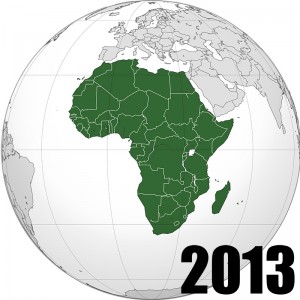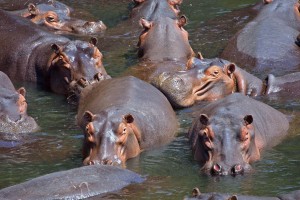 Africa Population 2013
Africa Population 2013
Africa is the world’s second-largest and second-most-populous continent with a population of 1.033 billion people. The continent is surrounded by the Mediterranean Sea to the north, both the Suez Canal and the Red Sea along the Sinai Peninsula to the northeast, the Indian Ocean to the southeast, and the Atlantic Ocean to the west. The continent includes Madagascar and various archipelagoes. It has 54 fully recognized sovereign states and countries, 9 territories and two de facto independent states with limited or no recognition.
Africa Population Growth
AFRICA’S fast-growing population boom is being seen as both a blessing and a curse with some seeing it as a decisive boost for economic growth and a unique opportunity for development. The dramatic growth began in the second half of the 20th century, when the number of people on the continent almost quadrupled from 230 million to 811 million. This had reached one billion by 2010, according to the United Nations World Population Prospects. If current demographic trends persist, the population will increase to 1.4 billion in 2025 and 1.9 billion in 2050. One in every three children in the world will be born in Sub Saharan Africa.
Africa Land Mass
At about 30.2 million km² (11.7 million sq mi) including adjacent islands, it covers six percent of the Earth’s total surface area and 20.4 percent of the total land area. With 1.033 billion people. Africa’s population accounts for about 15% of the world’s human population.
Africa Climate
Africa’s climatic zones are largely controlled by the continent’s location astride the equator and its almost symmetrical extensions into the Northern and Southern Hemispheres. Thus, except where altitude exerts a moderating influence on temperature or precipitation, Africa may be divided into six general climatic regions. Areas near the equator and on the windward shores of SE Madagascar have a tropical rain forest climate, with heavy rain and high temperatures throughout the year. North and south of the rain forest are belts of tropical savanna climate, with high temperatures all year and a seasonal distribution of rain during the summer season. The savanna grades poleward in both hemispheres into a region of semiarid steppe and then into the arid conditions of the extensive Sahara and the Kalahari. Belts of semiarid steppe with limited winter rain occur on the poleward sides of the desert regions. At the northern and southern extremities of the continent are narrow belts of Mediterranean-type climate with subtropical temperatures and a concentration of rainfall mostly in the autumn and winter months.
History of Man in Africa
About 1.75 million years ago, early man spread throughout parts of Africa. They became aggressive hunters, lived in caves and used fire and their ability to create stone tools just to survive.
The Neanderthals arose some 200,000 years ago and inhabited regions in northern Africa and across parts of southern Europe. There is also clear evidence that they had control of fire, lived in caves, as well as open-air structures of stone and vegetation.
 African Wildlife
African Wildlife
Africa is a huge continent that’s made up of many different habitats, including sand, rock, water and grass. Each of those habitats is the perfect place for all sorts of cool creatures to live. The hippo is responsible for more human fatalities in Africa than any other large animal. Male hippos actively defend their territories which run along the banks of rivers and lakes. Females have also been known to get extremely aggressive if they sense anyone coming in between their babies, who stay in the water while she feeds on the shore. Hippos can run at speeds of over 20 miles an hour and they have enormous jaws which host up to 20 inch canines.
Africa’s Nile River
The Nile River is the longest river in the world. It rises south of the Equator and flows northward through northeastern Africa to drain into the Mediterranean Sea. It has a length of about 4,132 miles (6,650 kilometres) and drains an area estimated at 1,293,000 square miles (3,349,000 square kilometres). Its basin includes parts of Tanzania, Burundi, Rwanda, the Democratic Republic of the Congo, Kenya, Uganda, South Sudan, Ethiopia, Sudan, and the cultivated part of Egypt. Its most distant source is the Kagera River in Burundi.
Africa’s Sahara Desert
The Sahara Desert is located in the northern portion of Africa and covers over 3,500,000 square miles (9,000,000 sq km) or roughly 10% of the continent. It is bounded in the east by the Red Sea and it stretches west to the Atlantic Ocean. To the north, the Sahara Desert’s northern boundary is the Mediterranean Sea, while in the south it ends at the Sahel, an area where the desert landscape transforms into a semi-arid tropical savanna.
The Sahara covers parts of several African nations including Algeria, Chad, Egypt, Libya, Mali, Mauritania, Morocco, Niger, Sudan and Tunisia. Most of the Sahara Desert is undeveloped and features a varied topography. Most of its landscape has been shaped over time by wind and includes sand dunes, sand seas called ergs, barren stone plateaus, gravel plains, dry valleys and salt flats. Around 25% of the desert is sand dunes, some of which reach over 500 ft (152 m) in height.
Top 5 African Countries By Population
| Rank | Country | Population |
| 1 | Nigeria | 177,096,000 |
| 2 | Ethiopia | 86,614,000 |
| 3 | Egypt | 84,605,000 |
| 4 | Democratic Republic of the Congo | 74,618,000 |
| 5 | South Africa | 52,982,000 |
Africa’s Population Growth
Other Resources
To learn more about the population of Africa, click here
Learn more about the continental statistics of Europe Population 2013.
Interactive World Population by Continent Map


